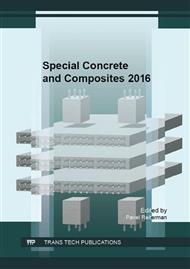p.216
p.222
p.228
p.235
p.241
p.247
p.254
p.260
p.267
Experimental Analysis of Strengthening of Dapped-End Beams
Abstract:
Technology of precast reinforced concrete finds its application in construction of buildings as well as transport infrastructure. Placement of a dapped-end beam on a corbel is one of the typical details for this construction technology. Designing of a dapped-end is crucial for the whole beam because any potential crack decreases the overall stiffness of the beam and can cause a collapse of the whole structure in the worst case. This paper presents results of an experimental research which was performed on a set of 6 small-scale dapped-end beams. Two different ways of prestressing were applied to experimental specimens and their ultimate-load bearing capacity were compared with plain concrete samples and with reinforced concrete samples. The results of this work suggest that horizontal prestressing technique is more efficient than vertical prestressing technique if the same prestressing force is applied.
Info:
Periodical:
Pages:
241-246
Citation:
Online since:
December 2016
Authors:
Price:
Сopyright:
© 2017 Trans Tech Publications Ltd. All Rights Reserved
Share:
Citation:


